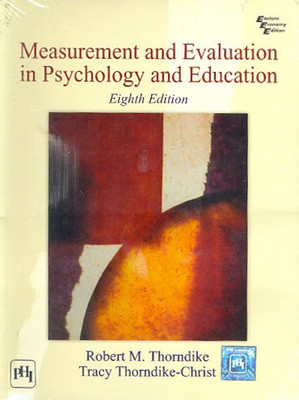Measurement and Evaluation in Psychology and Education(English, Paperback, M. Thorndike Robert)
Quick Overview
Product Price Comparison
In this classic introduction to educational and psychological measurement, Thorndike and Thorndike-Christ provide all of the pertinent information future professionals need to know in order to develop the skills to use test information wisely. Incorporating standard measurement concepts as they apply to both educational and psychological assessments, the new eighth edition continues to provide a technically rigorous treatment of the core issues in measurement in an easy-to-read, easy-to-understand presentation. In preparing students to become independent users of test information, it describes problems in measurement, explains how these problems are approached and solved, surveys a broad range of sources, and provides guidance in how to find, evaluate, and use information about specific tests. The new eighth edition of Measurement and Evaluation in Psychology and Education includes increased coverage of No Child Left Behind, extended coverage of the role of ethics in tests, and a new chapter on advanced topics in testing. Part Two of the book has been reorganized to clarify concepts and the book as a whole has been streamlined and updated to include the most current research and testing information. Intended for use in undergraduate or graduate level introductory courses in psychological and educational measurement, Measurement and Evaluation in Psychology and Education focuses on basic issues in measurement provides a general overview that is not overly specialized. Salient Features "Making the Computer Do It" feature walks students through using SPSS and Excel to perform basic statistical analysis, helping students to understand statistical and measurement concepts without having to do manual computations. A Straightforward introduction to the logic of Item Response Theory (IRT) explains the rationale behind this complex concept clearly and simply to readers, making this fundamental but often confusing tenet of measurement truly understandable. An in-depth chapter on assessing individuals with disabilities and English language learners that focuses on the most current "best practice" recommendations. This chapter illustrates the benefits and challenges of education's current emphasis on inclusion and discusses key issues related to assessment of students for whom English is not their dominant language. A separate chapter on practical issues related to using tests, including how and where to find information about tests, provides students with step-by-step guidance on how to administer and evaluate tests and points students toward reliable sources of information on a wide range of tests and testing tools. This is the only text of its kind to include such testing information. Numerous examples of tests items from all the major tests that a professional will encounter familiarize readers with test contents and help students to come to a deeper and more concrete understanding of individual tests and what they really measure. Exercises at the end of every chapter give students an opportunity to apply chapter concepts for review and retention and allows them to practice using the measurement and interpretation techniques that they have just learned.


